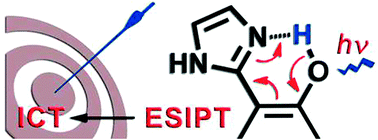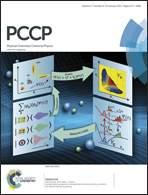Effective targeting of proton transfer at ground and excited states of ortho-(2′-imidazolyl)naphthol constitutional isomers†
Abstract
Steady-state and time-resolved spectroscopy and quantum chemical computational studies were employed to investigate ground and excited state proton transfer of a novel series of ortho-(1H-imidazol-2-yl)naphthol constitutional isomers: 1-(1H-imidazol-2-yl)naphthalen-2-ol (1NI2OH), 2-(1H-imidazol-2-yl)naphthalen-1-ol (2NI1OH) and 3-(1H-imidazol-2-yl)naphthalen-2-ol (3NI2OH). Proper Near Attack Conformations (NACs) involving a strong intramolecular hydrogen bond between the naphthol moiety and the ortho-imidazole group account for the highest ground state acidity of 2NI1OH compared with 1NI2OH and 3NI2OH. Moreover, ESIPT for 2NI1OH and 3NI2OH is further associated with planar chelate H-ring formation whereas 1NI2OH shows the highest ESIPT barrier and a noncoplanar imidazole group. In addition to energetic and structural requirements, the final state also depends on electronic configuration of the ESIPT product with the neutral 3NI2OH showing an ICT effect that correlates with the excited state pKa of the cationic species.


 Please wait while we load your content...
Please wait while we load your content...